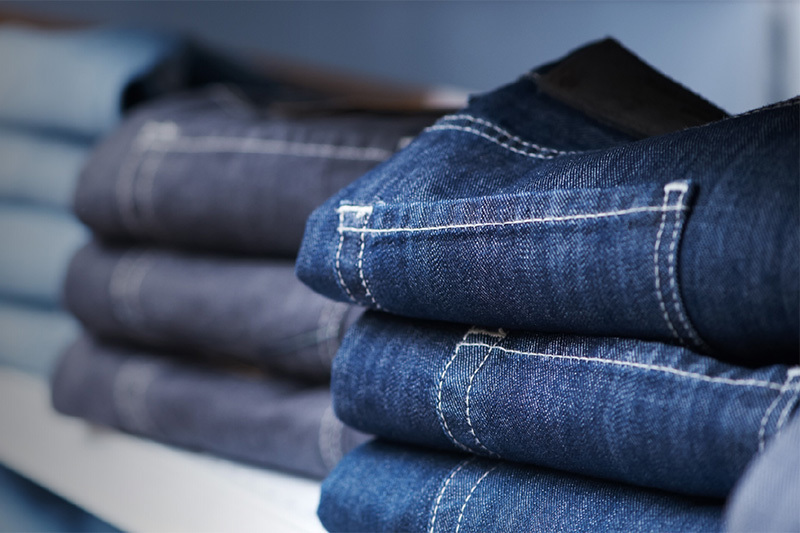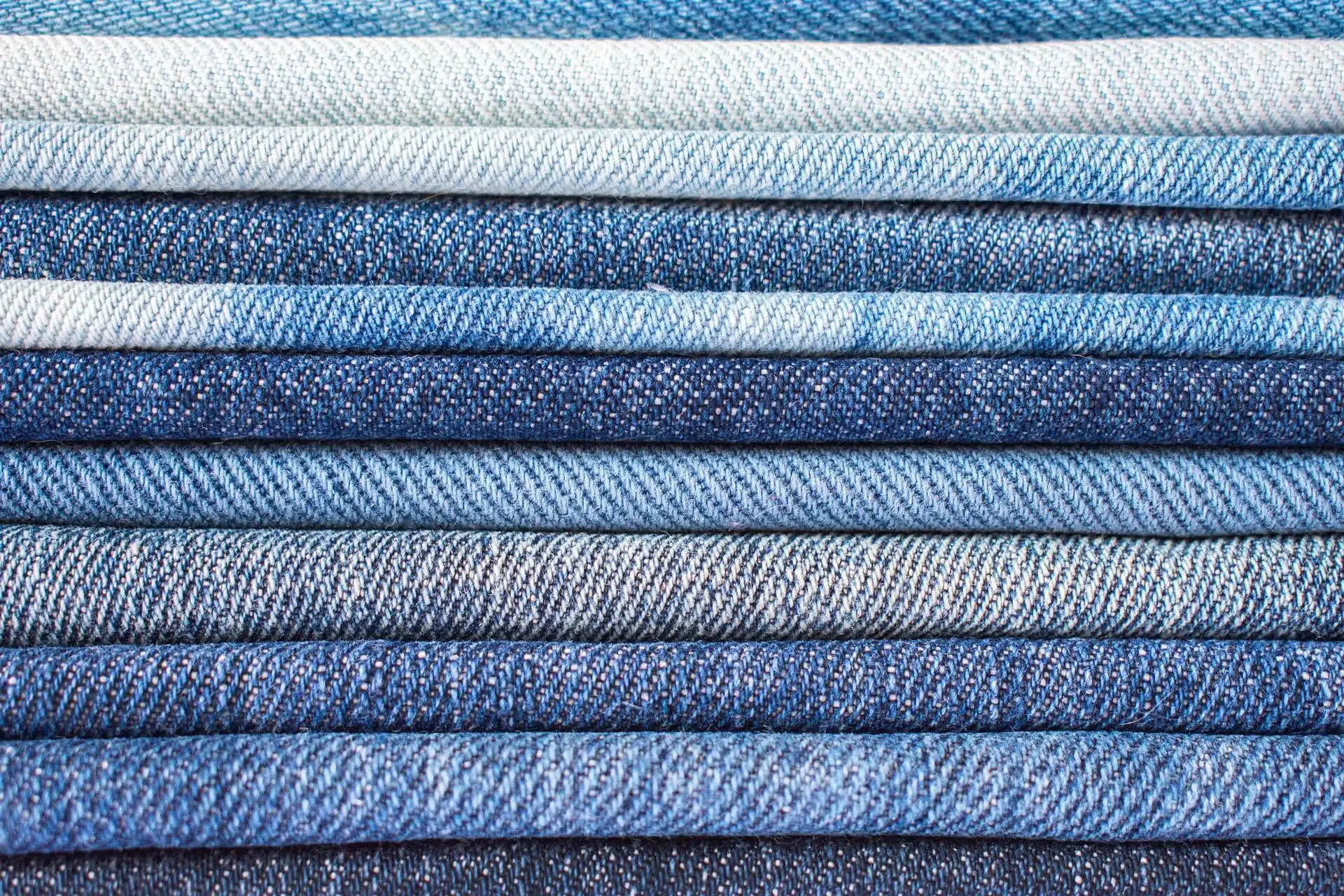Revealing the Secrets of Denim Manufacturing: From Basic Knowledge to Diverse Decorative Effects
Release time:
13 Mar,2025
Denim fabric thickness: Common denim fabric thickness ranges from 8 ounces to 12 ounces. Among them, 5-ounce thickness is very light and thin, suitable for making summer women's shirts and dresses; while 5-ounce is a thicker fabric, suitable for making winter jackets and cotton-padded coats.

Basic Knowledge
Denim Fabric Thickness: Common denim fabric thickness ranges from 8 ounces to 12 ounces. Among them, 5 ounces is very thin and suitable for making summer women's shirts and dresses; while 5 ounces is a thicker fabric, suitable for making winter jackets and cotton-padded coats.
Types of Denim Fabric: Common denim fabrics on the market include plain weave, twill, herringbone, interlaced weave, dark weave, and flocked denim, each with its own unique characteristics.
Denim Fabric Composition: Denim fabric composition varies, including 100% cotton, those with added elasticity (such as Lycra), cotton and linen blends, or those containing special components such as Tencel. These different fabric compositions have different wearing experiences and appearances.
Sewing Process
Stitching: In denim clothing production, stitching is an indispensable part. Common stitching types include 2-point single-side double-exposed stitching, as well as 2-point single-exposed stitching, 2-point double-side double-exposed stitching, etc. The stitching color is usually earth yellow, creating a contrasting effect with the denim fabric. There are also color-matched stitching, zigzag stitching, thickened hand-embroidered stitching and other options to add features to the garment.
Accessories: Denim clothing has a rich variety of accessories, including grommets, four-hole buttons, studs, rivets, leather patches and rhinestones, etc. These accessories not only play a decorative role but also enhance the durability and practicality of the garment.
Labels: In denim clothing, labels are an indispensable part. They include main labels, size labels, washing labels, flag labels, and side labels, providing important information about the garment, such as Brand, size, and washing instructions.
Decorative Processes
Frayed Edges: By cutting and pulling out the fibers at specific parts of the jeans (such as the hem), a unique frayed edge decorative effect is created, adding to the fashion sense and personality charm of the garment.
Rhinestone Application: Using high temperature to melt the adhesive on the back of rhinestones, and then sticking the rhinestones onto the fabric to create a variety of patterns and colors. This decorative process is very popular among women, adding sparkle and romance to the garment.
Glue Printing: By mixing special chemical gels with dyes and then attaching them to the fabric to form unique patterns and text. However, it should be noted that glue printing may make the fabric feel stiff, and it is easy to fall off after multiple washes.
Laser Engraving: Burning away the color of the denim to reveal the original color of the fabric. This decorative process can be combined with different fabrics such as wool, imitation leather, corduroy, and thick knit fabrics to create a variety of visual effects.
Washing, as a key process for denim garments, gives each denim garment a unique "time-worn" look. Through different washing methods, such as ordinary washing, stone washing, enzyme washing, etc., denim garments present different visual effects and wearing experiences. Next, we will delve into these washing methods and their impact on denim garments.
Ordinary washing is a relatively gentle washing method. Under the action of suitable water temperature and detergent, after a certain period of washing, and then treated with clean water and softener, the fabric becomes soft and comfortable, and the visual appearance is more natural and clean.
Stone washing is a process that achieves the washing effect through friction between pumice and garments. According to customer needs, different stones such as yellow stone and white stone can be selected for washing to create different degrees of damage and fading effects, making the fabric surface appear gray, old, and worn.
Enzyme washing uses the degrading effect of enzymes on the fiber structure to allow the fabric surface to fade and produce a "peach skin" effect relatively gently, while obtaining lasting softness.
Sand washing is achieved through the action of alkaline oxidizing agents, causing the garment to fade and create a sense of age. If used with stone grinding, a soft layer of frosty white fluff will be formed on the surface of the fabric. After adding softener, the fabric becomes soft and comfortable, improving the wearing comfort.
Chemical washing is a process that uses strong alkaline agents to achieve fading. After washing, the garment has an obvious sense of age. After being treated with a softener, the garment will show a soft and full effect. If stones are added for friction during chemical washing, it is called chemical stone washing, which can enhance the fading and abrasion effects, making the garment show a stronger sense of age.
Destruction washing is a process where, after the finished garment is polished with pumice and treated with an agent, a certain degree of damage occurs in certain parts, such as bone positions and collar corners, thus forming an obvious worn effect.
Snowflake washing is an innovative washing process. Through the friction reaction of potassium permanganate solution and garments, a fading effect similar to snowflakes is formed on the fabric.
In addition, there are special processes such as whisker and spray monkey. Whiskers are unique decorations formed by hand-sanding into specific shapes and then rubbing against the garment; while spray monkey is a process that uses a spray gun to spray potassium permanganate solution onto the garment according to the design requirements, causing the fabric to fade through a chemical reaction, forming specific patterns and effects.
After understanding these rich washing methods and special processes, we also need to pay attention to the issue of washing and maintenance. Proper washing and maintenance methods can prolong the life of denim garments and maintain their good wearing effect.
Before washing, add one or two spoons of salt to the basin, then add a small amount of white vinegar and stir well. Then put the denim garment into the basin and soak for about 10-15 minutes. This helps to reduce the fading of denim clothes and soften the garment. After soaking, add an appropriate amount of detergent and rub the garment to ensure that the detergent is evenly distributed.
When washing denim garments, use cold water instead of hot water and choose a neutral detergent. At the same time, it is recommended to wash the garment with the wrong side facing up to avoid direct contact with bleach and softener.
To prevent denim garments from being dyed during cleaning, some vinegar and salt can be added for soaking before washing. In addition, dark and light-colored garments should be washed separately.
When drying denim pants, they should be hung flat from the waist and turned over to dry in a dry and ventilated place. Avoid sun exposure to prevent serious fading or hardening.
Denim clothing doesn't need frequent washing. Usually, washing after wearing it three to five times is sufficient. Reducing the number of washes is one of the important ways to maintain denim clothing.
Denim clothing is best hand-washed and avoid excessive rubbing. If machine washing is necessary, choose a tumble dryer and ensure that the zippers are zipped up or the buttons are fastened. Choose to reverse tumble dry for 1 minute and low-temperature dry.
For denim clothing with special craftsmanship such as rhinestones, rivets, and leather patches, it is recommended to send it to a professional laundry for washing and care, as home washing may cause damage.
- All
- Product Management
- News
- Introduction
- Enterprise outlets
- FAQ
- Enterprise Video
- Enterprise Atlas
More information







